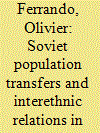| Srl | Item |
| 1 |
ID:
046966


|
|
|
|
|
| Publication |
Cambridge, Harvard University Press, 2001.
|
| Description |
248p.
|
| Standard Number |
0674003136
|
|
|
|
|
|
|
|
|
|
|
|
Copies: C:1/I:0,R:0,Q:0
Circulation
| Accession# | Call# | Current Location | Status | Policy | Location |
| 044214 | 305.80094/NAI 044214 | Main | On Shelf | General | |
|
|
|
|
| 2 |
ID:
146230


|
|
|
|
|
| Summary/Abstract |
Since control over the population constitutes the most crucial determinant for victory in irregular warfare, how should a state authority isolate the insurgents (the “fish” in Maoist terms) from the population (the “sea” in which the “fish” thrive)? Should a state authority simply drain the “sea” by diverting its “water” elsewhere? Does the forcible transfer of the local people who support an insurgency truly work? This article studies how the royalist regime of Greece forcibly transferred thousands of villagers (over 10% of the total population) to counter the communist insurgency during the Greek Civil War (1946–1949) and shows whether and how these deportations could be crowned with success.
|
|
|
|
|
|
|
|
|
|
|
|
|
|
|
|
| 3 |
ID:
104059


|
|
|
|
|
| Publication |
2011.
|
| Summary/Abstract |
This article explores a key event in the recent history of Central Asia: the 1950s Soviet policy of forced transfers of highlanders down to cotton kolkhozes in the Ferghana Valley. From both a historical and sociological perspective, the article analyses how the displaced population was received in the areas of destination. It sheds light on the concept of ethnicity, in the sense that these transfers were most often analysed in ethnic terms. This approach does not allow for the perception of a complex range of identities based on a nation, a region, a lineage, a religion or a language. The concept of ethnicity seems therefore limited to explain the social dynamics of nation-state formation in a region where identity appears to be multiple, changing and constantly renegotiated.
|
|
|
|
|
|
|
|
|
|
|
|
|
|
|
|